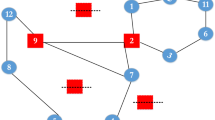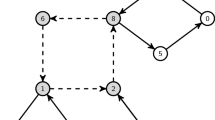Abstract
In this paper, we present a memetic algorithm (MA) for solving the uncapacitated single allocation hub location problem (USAHLP). Two efficient local search heuristics are designed and implemented in the frame of an evolutionary algorithm in order to improve both the location and allocation part of the problem. Computational experiments, conducted on standard CAB/AP hub data sets (Beasley in J Global Optim 8:429–433, 1996) and modified AP data set with reduced fixed costs (Silva and Cunha in Computer Oper Res 36:3152–3165, 2009), show that the MA approach is superior over existing heuristic approaches for the USAHLP. For several large-scale AP instances up to 200 nodes, the MA improved the best-known solutions from the literature until now. Numerical results on instances with 300 and 400 nodes introduced in Silva and Cunha (Computer Oper Res 36:3152–3165, 2009) show significant improvements in the sense of both solution quality and CPU time. The robustness of the MA was additionally tested on a challenging set of newly generated large-scale instances with 520–900 nodes. To the best of our knowledge, these are the largest USAHLP problem dimensions solved in the literature until now. In addition, in this paper, we report for the first time optimal solutions for 30 AP and modified AP instances.

Similar content being viewed by others
Explore related subjects
Discover the latest articles, news and stories from top researchers in related subjects.References
Abdinnour-Helm S (1998) A hybrid heuristic for the uncapacitated hub location problem. Eur J Oper Res 106:489–499
Abdinnour-Helm S, Venkataramanan MA (1998) Solution approaches to hub location problems. Annals Oper Res 78:31–50
Acampora G, Cadenas JM, Loia V, Ballester EM (2011) Achieving memetic adaptability by means of agent-based machine learning. IEEE Trans Ind Inform 7(4):557–569
Acampora G, Loia V, Salerno S, Vitiello A (2012) A hybrid evolutionary approach for solving the ontology alignment problem. Int J Intell Syst 27(3):189–216
Alumur S, Kara BY (2008) Network hub location problems: the state of the art. Eur J Oper Res 190(1):1–21
Beasley JE (1996) Obtaining test problems via internet. J Global Optim 8(4): 429–433
Campbell JF, Ernst A, Krishnamoorthy M (2002) Hub location problems. In: Hamacher H, Drezner Z (eds) Location theory: applications and theory. Springer, Berlin/Heidelberg, pp 373–407
Chen JA (2007) A hybrid heuristic for the uncapacitated single allocation hub location problem. OMEGA Int J Manag Sci 35:211–220
Crescenci P, Kann V (1997) A compendium of NP optimization problems. http://www.nada.kth.se/theory/problemlist.html
Cunha CB, Silva MR (2007) A genetic algorithm for the problem of configuring a hub-and-spoke network for a LTL trucking company in Brazil. Eur J Oper Res 179:747–758
Ernst AT, Krishnamoorthy M (1998) Exact and heuristic algorithms for the uncapacitated multiple allocation p-hub median problem. Eur J Oper Res 104:100–112
Ernst AT, Krishnamoorthy M (1999) Solution algorithms for the capacitated single allocation hub location problem. Annals Oper Res 86:141–159
Filipović V (2003) Fine-grained tournament selection operator in genetic algorithms. Comput Inform 22:143–161
Filipović V, Kratica J, Tošić D, Dugošija Dj (2009) GA inspired heuristic for uncapacitated single allocation hub location problem. Adv Soft Comput 58:149–158
Galinier P, Boujbel Z, Fernandes MC (2011) An efficient memetic algorithm for the graph partitioning problem. Annals Oper Res 191(1):1–22
Garey MR, Johnson DS (1979) Computers and Intractibility: a guide to the theory of NP completness. W.H. Freeman and Co., San Francisco
Goh CK, Teoh EJ, Tan KC (2009) A hybrid evolutionary approach for heterogeneous multiprocessor scheduling. Soft Comput 13(8–9):833–846
Ilić A, Urošević D, Brimberg J, Mladenović N (2010) A general variable neighborhood search for solving the uncapacitated single allocation p-hub median problem. Eur J Oper Res 206:289–300
Ishibuchi H, Hitotsuyanagi Y, Tsukamoto N, Nojima Y (2009) Use of biased neighborhood structures in multiobjective memetic algorithms. Soft Comput 13(8–9):795–810
Klincewicz JG (1991) Heuristics for the p-hub location problem. Eur J Oper Res 53:25–37
Klincewicz JG (1992) Avoiding local optima in the p-hub location problem using tabu search and GRASP. Annals Oper Res 40:283–302
Kratica J, Milanović M, Stanimirović Z, Tošić D (2011) An evolutionary-based approach for solving a capacitated hub location problem. Appl Soft Comput 11(2):1858–1866
Labbé M, Yaman H (2004) Projecting flow variables for hub location problems. Networks 44(2):84–93
Michalewicz Z (1996) Genetic Algorithms + Data Structures = Evolution Programs, 3rd edn. Springer, Berlin
Moscato PA, Cotta C (2003) A gentle introduction to memetic algorithms. In: Glover F, Kochenberger G (eds) Handbook of metaheuristics. Kluwer Academic Press, Boston, pp 105–144
Moscato PA, Cotta C (2007) Memetic algorithms. In: Gonz\(\acute{a}\)les T (ed) Handbook of approximation algorithms and metaheuristics. Taylor&Francis, London, (ch. 27)
Neri F, Cotta C, Moscato P (2012) Handbook of memetic algorithms. Studies in computational intelligence, vol. 379. Springer, Berlin/Heidelberg
O’Kelly, ME (1987) A quadratic integer program for the location of interacting hub facilities. Eur J Oper Res 32:393–404
O’Kelly ME (1992) Hub facility location with fixed costs. J Reg Sci Assoc Int 3(71):293–306
Özcan E, Başaran C (2009) A case study of memetic algorithms for constraint optimization. Soft Comput 13(8–9):871–882
Prins C, Prodhon C, Calvo R (2006) A memetic algorithm with population management (MA|PM) for the capacitated location-routing problem. Evol Comput Comb Optim 3906:181–192
Ribeiro CC, Hansen P (2002) Essays and surveys in metaheuristics. Kluwer Academic, Boston
Silva MR, Cunha CB (2009) New simple and efficient heuristics for the uncapacitated single allocation hub location problem. Computers Oper Res 36:3152–3165
Skorin-Kapov D, Skorin-Kapov J (1994) On tabu search for the location of interacting hub facilities. Eur J Oper Res 73:502–509
Soak SM, Lee SW, Mahalik NP, AhnA BH (2006) New memetic algorithm using particle swarm optimization and genetic algorithm. Lect Notes Computer Sci 4251:122–129
Stanimirović Z (2007) Solving the capacitated single allocation hub location problem using genetic algorithm. In: Skiadas CH (ed) Recent advances in stochastic modelling and data analysis. World Scientific Publishing Co Pte Ltd, pp 464–471
Stanimirović Z, Kratica J, Dugošija Dj (2007) Genetic algorithms for solving the discrete ordered median problem. Eur J Oper Res 182:983–1001
Stanimirović Z (2008) An efficient genetic algorithm for the uncapacitated multiple allocation p-hub median problem. Control Cybern 37(3):669–692
Stanimirović Z (2010) A genetic algorithm approach for the capacitated single allocation p-hub median problem. Comput Inform 29(1):117–132
Topcuoglu H, Court F, Ermis M, Yilmaz G (2005) Solving the uncapacitated hub location problem using genetic algorithms. Computers Oper Res 32:967–984
Wang H, Wan D, Yang S (2009) A memetic algorithm with adaptive hill climbing strategy for dynamic optimization problems. Soft Comput 13 (8–9):763–780
Acknowledgments
This research was partially supported by Serbian Ministry of Science and Technological Development under the Grants No. 174010 and 47017. We thank M.R.Silva for providing us the test-instances for the USAHLP.
Author information
Authors and Affiliations
Corresponding author
Appendices
Appendix 1
In Tables 14 and 15 we present detailed results of the MA method on CAB instances. The largest CAB instance contains 25 nodes, while the smaller ones with 10, 15 and 20 nodes are obtained as its subsets. For each CAB instance, we considered four values of fixed costs: 100, 150, 200 and 250.
Stopping criteria imposed on the MA for the CAB data set are: G max = 50 and R max = 20.
From the results presented in Tables 14 and 15, it is obvious that the MA approach reaches all known optimal solutions in extremely short CPU times. Other heuristic methods, the HubTS, MSTS-3 and GA, have similar performance: all three of them are executed very quickly providing optimal solutions on all CAB instances. The optimal solutions for CAB data set and AP instances with 10 ≤ n ≤ 50 and n = 100 are obtained by CPLEX 9.1 solver and taken from Silva and Cunha (2009), together with corresponding CPU times.
Appendix 2
The new large-scale instances including n = 520, 600, 720, 800, 900 nodes with tight and loose fixed costs are created in the following way:
-
We use two constants d min = 500 and d max = 2,000, taken from Silva and Cunha (2009). These values are chosen based on the average and maximum distances between two nodes in the original AP data set with 200 nodes;
-
In order to obtain a new instance with \(2\times n\) nodes from an original AP instance with n nodes we use the approach described in Silva and Cunha (2009). We will refer to this approach as Method 1
-
To generate new instance with \(3\times n\) nodes from an original AP instance with n nodes, for each node i in the original AP data set with n nodes located at (X i , Y i ), we generate three new nodes (X k i , Y k i ), k = 0, 1, 2, whose coordinates are calculated as:
$$ X_i^{k} = X_i + (d_{\rm{min}} + r_i\times(d_{\rm{max}}-d_{\rm{min}}))\times {\rm{cos}}(\varphi+2k\times\pi/3), k=0,1,2 $$and
$$ Y_i^{k} = Y_i + (d_{\rm{min}} + r_i\times(d_{\rm{max}}-d_{\rm{min}}))\times sin(\varphi+2k\times\pi/3), k=0,1,2, $$where r i is a random number within the [0,1] interval and \(\varphi\) is a random angle within the [0, π/3] interval. The new instance contains only newly generated nodes \((X_i^{k}, Y_i^{k}), k=0,1,2; i=1,\ldots,n.\) For any given pair of nodes (i, j) in the original AP data set, the corresponding amount of flow W ij is equally distributed among the nine newly generated pairs of nodes, that is: \(W_{ i^{k}j^{l}} = 1/9W_{ij}, k,l=0,1,2. \) The fixed costs for the new nodes are different and given by \(f_i^{k} = (1- r_i^{k})\times f_i, k=0,1,2, \) where r k i , k = 0, 1, 2 are three random numbers within the [0,0.3] interval. We will denote this approach for generating three times larger instance as Method 2;
-
Instance with 600 nodes is obtained from the original AP instance with 200 nodes, by applying the Method 2;
-
Instance of dimension n = 520 is created from the AP instance with n = 130 nodes, by applying the Method 1, which gives an instance with \(2\times 130=260\) nodes. The Method 1 is then applied again, producing an instance with 2 × 260 = 520 nodes;
-
The instance with n = 720 nodes is obtained from the original AP instance with n = 120. The Method 2 is first applied, creating an instance with \(3\times 120=360\) nodes. The Method 1 is then used to generate an instance of dimension 2 × 360 = 520;
-
Instance with n = 800 nodes is created from the AP instance with n = 200 in the same manner as the new instance with 520 nodes (i.e., Method 1 is applied two times);
-
By applying Method 2 on AP instance with 100 nodes, we obtain a instance of dimension n = 300, which is used to create the instance with n = 900 by using Method 2 again.
Rights and permissions
About this article
Cite this article
Marić, M., Stanimirović, Z. & Stanojević, P. An efficient memetic algorithm for the uncapacitated single allocation hub location problem. Soft Comput 17, 445–466 (2013). https://doi.org/10.1007/s00500-012-0919-0
Published:
Issue Date:
DOI: https://doi.org/10.1007/s00500-012-0919-0




